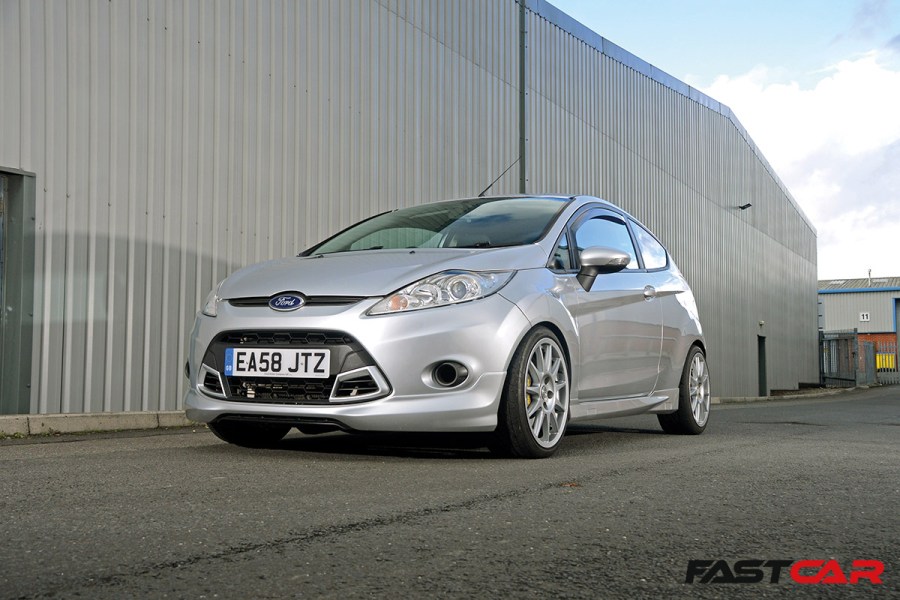Don’t be fooled by the standard looks of Terry Hough’s Mk7 Fiesta, under the tame exterior lurks an Evo-powered monster, with a lairy 400bhp and a full 4×4 swap. It’s a bit wild…
Inspired by Ford’s all-wheel-drive WRC Fiesta, Terry Hough had a vision to build a fully kitted-out replica ripe for a rally stage. But during the build his rallying plans were ditched and the project took a different direction – resulting in a 420bhp Mitsubishi Evo-powered stock-looking road-going Mk7 Fiesta. Needless to say, it creates quite a stir…
We first saw Terry’s crazy Fiesta at a very busy Oval Owners’ club meet; as it cruised into the car park at a sedate pace, people barely paid any attention to the TDCi-badged Mk7 – and that’s the whole point of this car. As sleepers go, this Fiesta must be one of the most discreet and unsuspecting examples we’ve ever seen.
But once the bonnet was opened, a crowd quickly formed. And, of course, his exit that day wasn’t quite so pedestrian – as the innocent-looking Fiesta fired off into the distance, a few wry smiles appeared.
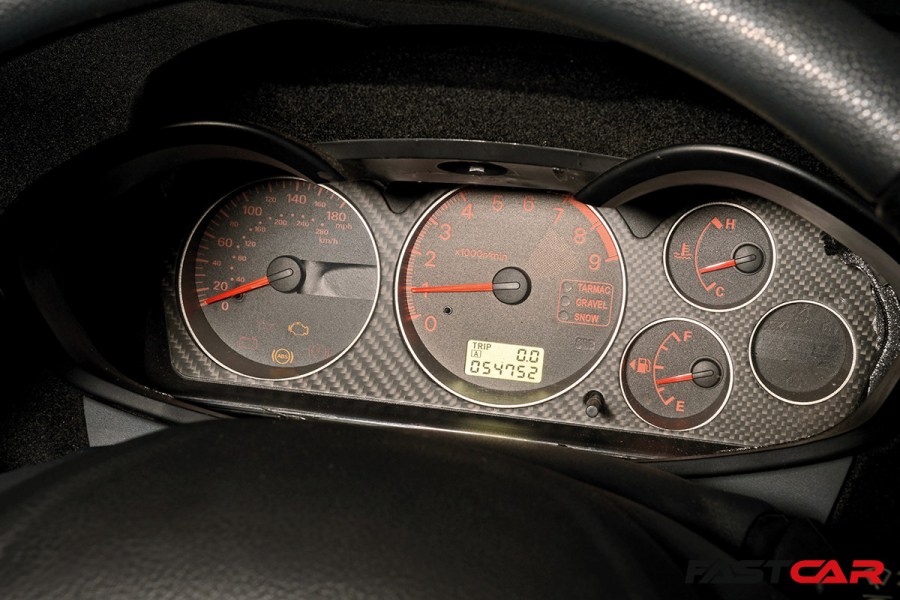
Terry’s car history
Terry has always been a fan of fast cars, and for the last 20 years there’s been no shortage of them in his possession. He says, “I’ve always liked my Fords, and had all sorts from XR2s and XR2is right up to an Escort Cosworth and a Sierra RS500 Cosworth. I also built a 300bhp Corsa GSi with a C20LET engine.”
Currently, a 700bhp Evo 8 MR and an RWD Sapphire Cosworth reside in the garage along with his Fiesta.
As we know, it’s not wise to unleash the full potential of such powerful machines on our roads. So, Terry, who happens to be quite talented behind the wheel, decided to take up rallying. He says, “I drove a Sapphire Cosworth and a Mitsubishi Evo 7, and both were great fun on stage rallies.” It was around this time that Terry was offered an accident-damaged Evo and spotted a niche in the market. He says, “At first the owner was planning to repair it, but it wouldn’t have been cost-effective. I offered to buy the car instead and broke it for parts.”
Having made a tidy profit, more damaged Evos arrived, and the parts continued to sell – at a time before investors took an interest in such cars and prices were still affordable.

Plan to build an Evo-powered Mk7 Fiesta
Seemingly content with his brace of rapid cars from two different marques and a lucrative side-business selling parts, it was while watching the WRC that Terry came up with an ambitious plan.
He recalls, “I was impressed by the new ford Fiesta WRC and had the idea to build something similar myself using an Evo-based platform. The difference was, it would have to be done on a much tighter budget.”
Armed with an array of Evo parts in his unit and knowing a donor Fiesta wouldn’t be too hard to obtain, a plan was hatched to marry up the Ford’s bodyshell with the Mitsubishi running gear.
Terry remembers, “As I was on a limited budget, I had no intentions of splashing out on a brand-new ST or anything like that. I managed to source a lightly-damaged Fiesta Zetec S TDCi, which I soon repaired.”
As the project progressed, Terry’s initial plans changed, though it wasn’t necessarily a bad thing.
He continues, “I priced up a Fiesta WRC bodykit and roll cage and they were out of reach. Coupled with the ever-changing rules in rallying, which meant I might never be able to compete in the car, even if I did build it, I had to look at an alternative plan of attack.”
Terry’s solution was to continue his ambitious project, but with a focus towards track days, hill climbs and upsetting owners of far more exotic cars on the road.
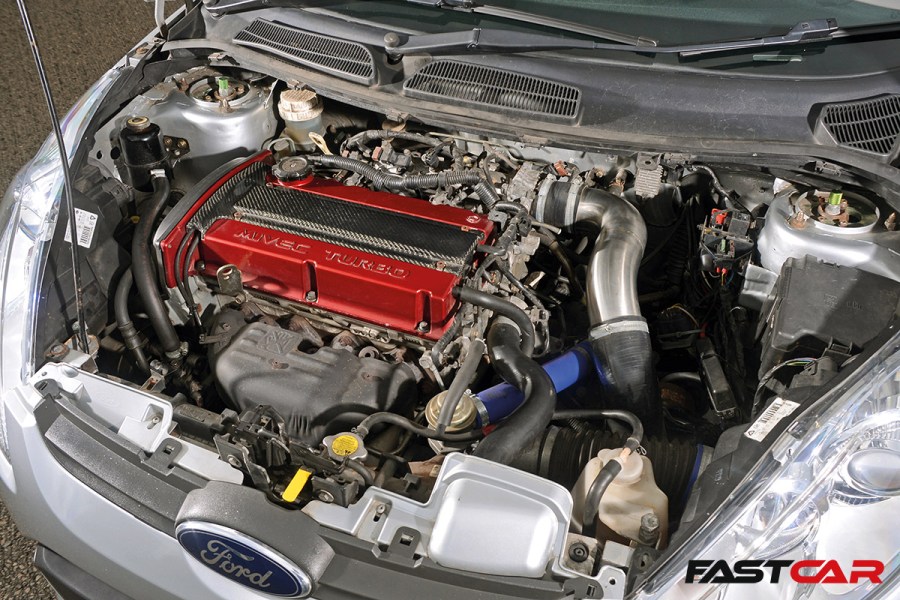
Evo VI RS donor car
When it came to choosing the Mitsubishi running gear, Terry’s wealth of experience meant he could select the best on offer from the vast Evo stable.
“I bought a complete Evo IV RS, as I knew certain parts were stronger and able to cope easily with big power upgrades. I didn’t fancy the idea of replacing major components every month,” he explains.
Just like any other project of this scale, careful measuring was necessary to ensure the Fiesta shell could be positioned correctly around the Evo’s chassis and running gear. The Evo IV’s narrower dimensions compared to its successors meant the driveshafts, suspension and arms would fit neatly under the Fiesta’s arches.
Meanwhile, the floor, inner wings and front and rear turrets all required time-consuming adaptation and fabrication to fit the Mk7’s measurements to ensure the exterior remained unsuspectingly standard.
Terry explains, “I had to unpick and cut down the Evo floorpan and turrets so I could use the Evo’s suspension setup. All of the spot welds on both cars had to be drilled out individually, which took ages.”
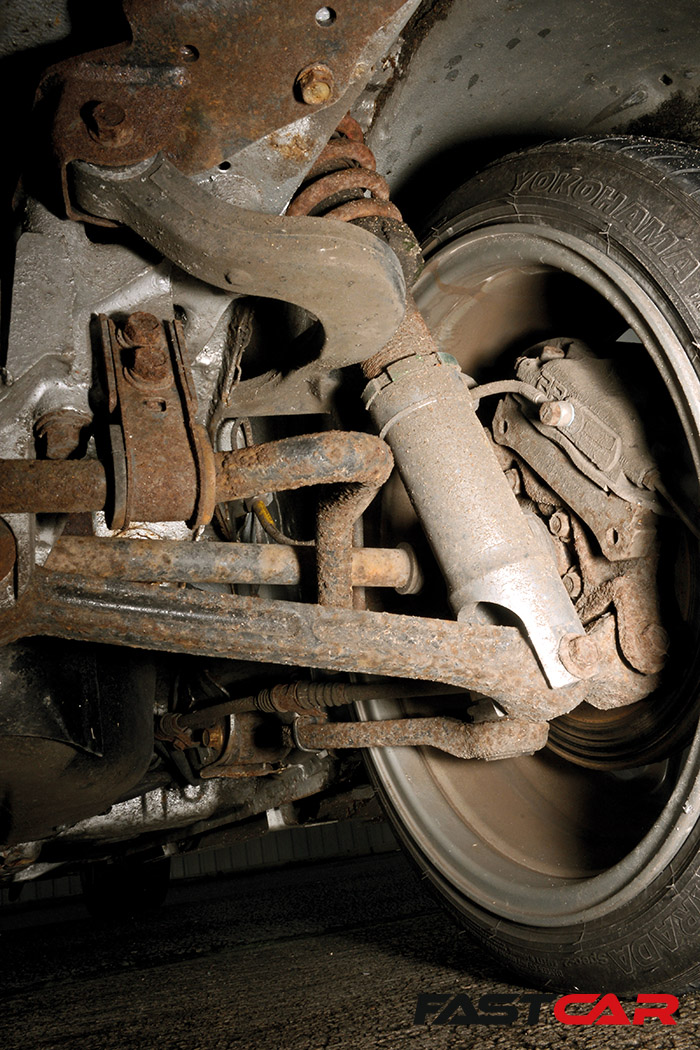
Custom fabrication on the Evo-powered Mk7 Fiesta
Although some of the Evo’s chassis could be carried over to the Fiesta, Terry fabricated the current front slam panel and boot floor. “I wanted to use the Evo’s radiator and intercooler, which required a custom panel to be made,” he explains.
Meanwhile, the smaller dimensions of the Fiesta boot required a custom floor into which the diff and suspension turrets could be mounted. The coilover suspension and AP six-pot front and four-pot rear disc brakes all originate from the Mitsubishi Evo stable and, combined with those relatively discreet but attractive 17in Speedline alloys, you’d be hard-pressed to notice any major differences from a standard Fiesta. As we said, the amount of fabrication work involved under the skin to achieve this is unreal.
Using the donor Evo RS meant the bulletproof front and rear diffs and close-ratio five-speed gearbox were able to handle the power of pretty much any engine Terry chose.
He smiles, “I opted for an Evo IX MIVEC engine with a Turbo Technics 5209 turbo upgrade. The ECU has since been remapped and runs 360bhp in standard form but is switchable up to 420bhp on high boost.”
Handily, the remainder of the Evo IX’s ancillaries, including the cooling system, could all be rehoused in the Fiesta’s shell, while there’s now a Walbro fuel pump in place along with a custom stainless 3.5in exhaust system.
Terry adds, “The hardest part while installing the engine was sorting the wiring loom. I had to cut and shorten the Evo’s loom and splice it into the Fiesta’s to ensure everything worked – that all proved to be a painstaking task.”
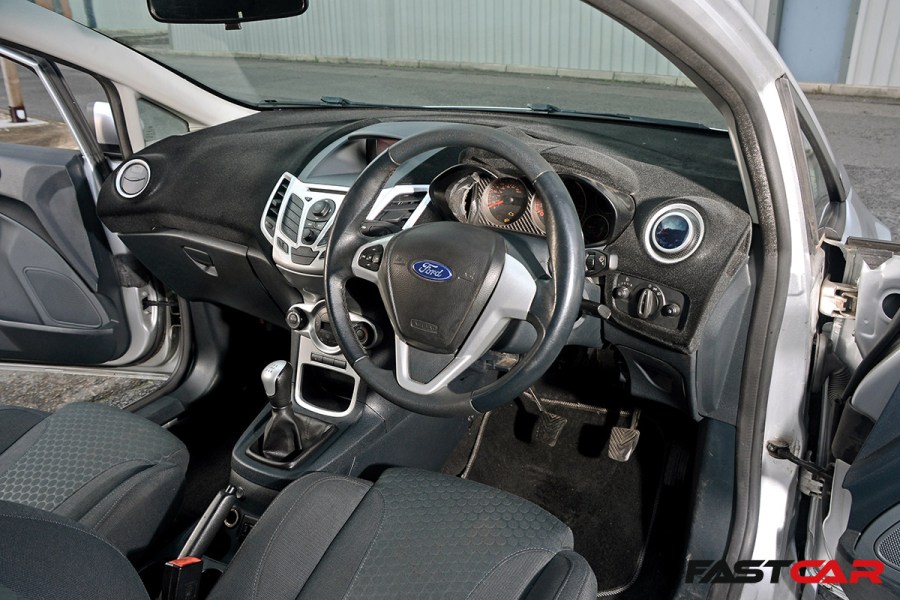
Evo-powered Mk7 Fiesta Interior
One aspect you may have expected Terry to change was the interior – fitting bucket seats would have been a walk in the park compared to the rest of the build. Yet, open the door and almost the entire interior remains just as Ford intended, right down to the standard Zetec S upholstery.
“I had to adapt the Evo clocks to fit inside the Fiesta’s binnacle and also fitted a boost gauge in the driver’s-side air vent,” Terry points out. “I’d put so much effort into keeping the exterior standard, I felt I had to do the same when it came to the interior.”
The whole project took just 18 months to complete, and when you consider how much work was involved, that’s incredible.
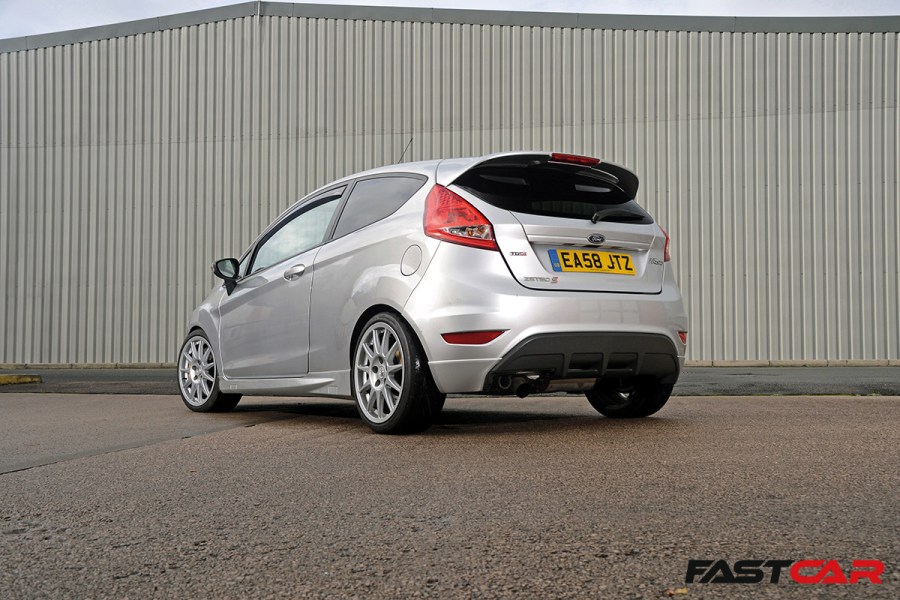
Evo-powered Mk7 Fiesta passenger ride
We were lucky enough to be treated to a passenger ride in this bonkers Fiesta on the day of our shoot and although we expected this car to be rapid, we were still in for a shock. Maybe it’s the standard interior and especially those familiar Zetec S spec seats that added to the wild and certainly memorable experience, but once Terry planted the throttle, the car that had been previously half-a-mile-or-so ahead was now right in front of us within the blink of an eye.
Coupled with the Evo’s 4×4 system and AP Racing brakes, it handles well too: roundabouts and bends are dispatched in deceptively quick succession, even in the wet. We’d go as far as saying this is one of the quickest road-legal Fiestas we’ve come across, and with a 0-to-60mph sprint in just 3.5 seconds, that’s hardly surprising.
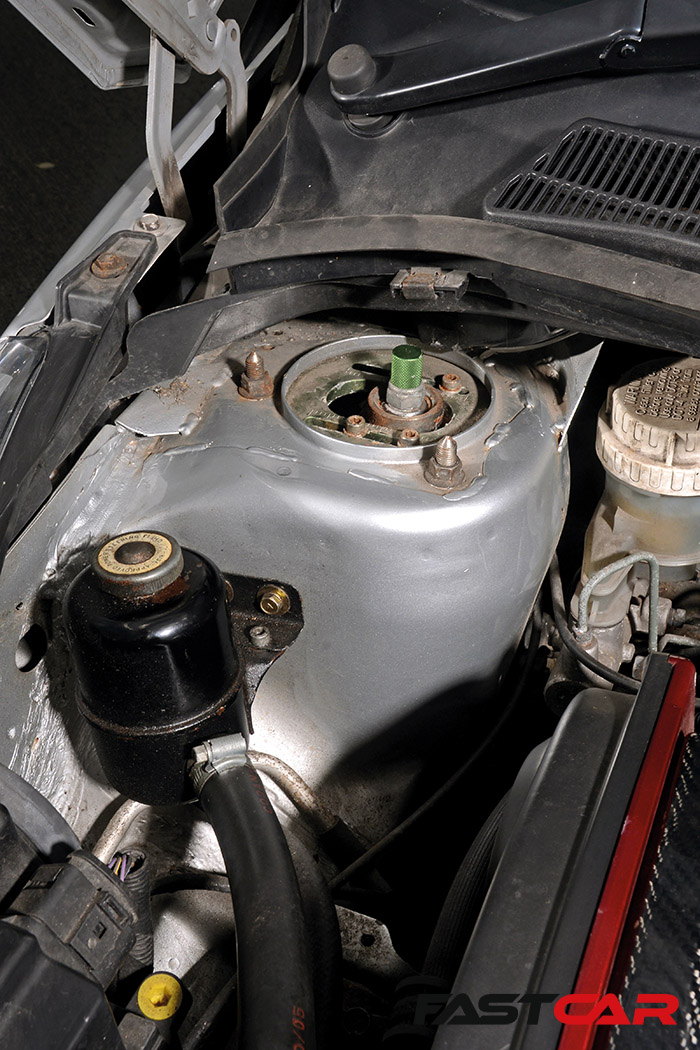
Verdict
Terry happily admits he changes his cars regularly, but he says this Fiesta will be staying with him for a long time yet. There are plans to extract even more power once the engine is forged, and with supporting upgrades added, this Fiesta should see an impressive 600bhp. There’s talk of entering more hillclimbs and track days too.
Yet this car comes into its own on the road where the grin factor is massive, and the majority of the public are clueless as to what lurks under the skin.
Terry says, “Even people who’ve noticed the 4×4 system are expecting to see a Cosworth engine, not a Mitsubishi conversion.”
This may not be a car for the purists, but if you happen to be an open-minded fan of a usable well-built sleeper, Terry’s ambitious creation surely ticks all the boxes.
Words & Photos: Jon Cass.
If you love fast Fords then you won’t want to miss our blockbuster Ford Fest event at Mallory Park this September 22nd! Head to the event website here to get in on the action!

